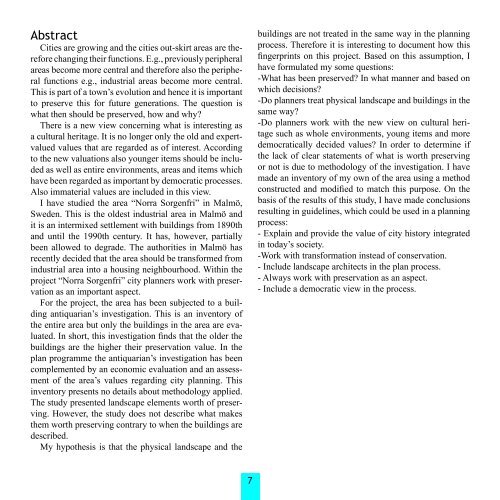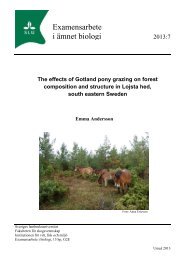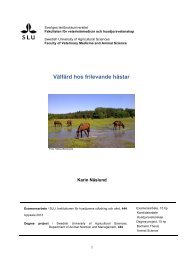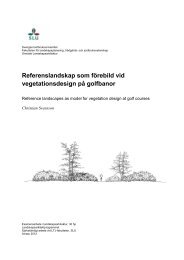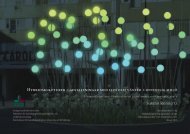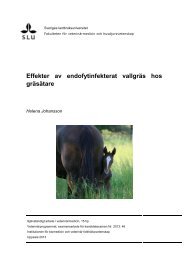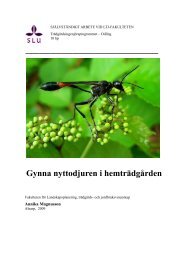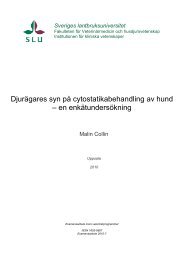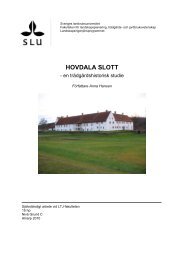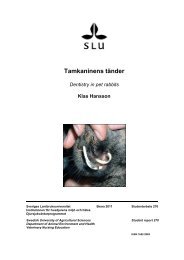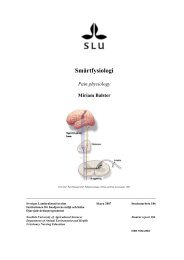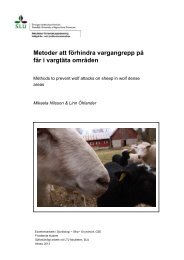PDF (examensarbete) - SLU
PDF (examensarbete) - SLU
PDF (examensarbete) - SLU
You also want an ePaper? Increase the reach of your titles
YUMPU automatically turns print PDFs into web optimized ePapers that Google loves.
Abstract<br />
Cities are growing and the cities out-skirt areas are therefore<br />
changing their functions. E.g., previously peripheral<br />
areas become more central and therefore also the peripheral<br />
functions e.g., industrial areas become more central.<br />
This is part of a town’s evolution and hence it is important<br />
to preserve this for future generations. The question is<br />
what then should be preserved, how and why?<br />
There is a new view concerning what is interesting as<br />
a cultural heritage. It is no longer only the old and expertvalued<br />
values that are regarded as of interest. According<br />
to the new valuations also younger items should be included<br />
as well as entire environments, areas and items which<br />
have been regarded as important by democratic processes.<br />
Also immaterial values are included in this view.<br />
I have studied the area “Norra Sorgenfri” in Malmö,<br />
Sweden. This is the oldest industrial area in Malmö and<br />
it is an intermixed settlement with buildings from 1890th<br />
and until the 1990th century. It has, however, partially<br />
been allowed to degrade. The authorities in Malmö has<br />
recently decided that the area should be transformed from<br />
industrial area into a housing neighbourhood. Within the<br />
project “Norra Sorgenfri” city planners work with preservation<br />
as an important aspect.<br />
For the project, the area has been subjected to a building<br />
antiquarian’s investigation. This is an inventory of<br />
the entire area but only the buildings in the area are evaluated.<br />
In short, this investigation finds that the older the<br />
buildings are the higher their preservation value. In the<br />
plan programme the antiquarian’s investigation has been<br />
complemented by an economic evaluation and an assessment<br />
of the area’s values regarding city planning. This<br />
inventory presents no details about methodology applied.<br />
The study presented landscape elements worth of preserving.<br />
However, the study does not describe what makes<br />
them worth preserving contrary to when the buildings are<br />
described.<br />
My hypothesis is that the physical landscape and the<br />
buildings are not treated in the same way in the planning<br />
process. Therefore it is interesting to document how this<br />
fingerprints on this project. Based on this assumption, I<br />
have formulated my some questions:<br />
-What has been preserved? In what manner and based on<br />
which decisions?<br />
-Do planners treat physical landscape and buildings in the<br />
same way?<br />
-Do planners work with the new view on cultural heritage<br />
such as whole environments, young items and more<br />
democratically decided values? In order to determine if<br />
the lack of clear statements of what is worth preserving<br />
or not is due to methodology of the investigation. I have<br />
made an inventory of my own of the area using a method<br />
constructed and modified to match this purpose. On the<br />
basis of the results of this study, I have made conclusions<br />
resulting in guidelines, which could be used in a planning<br />
process:<br />
- Explain and provide the value of city history integrated<br />
in today’s society.<br />
-Work with transformation instead of conservation.<br />
- Include landscape architects in the plan process.<br />
- Always work with preservation as an aspect.<br />
- Include a democratic view in the process.


